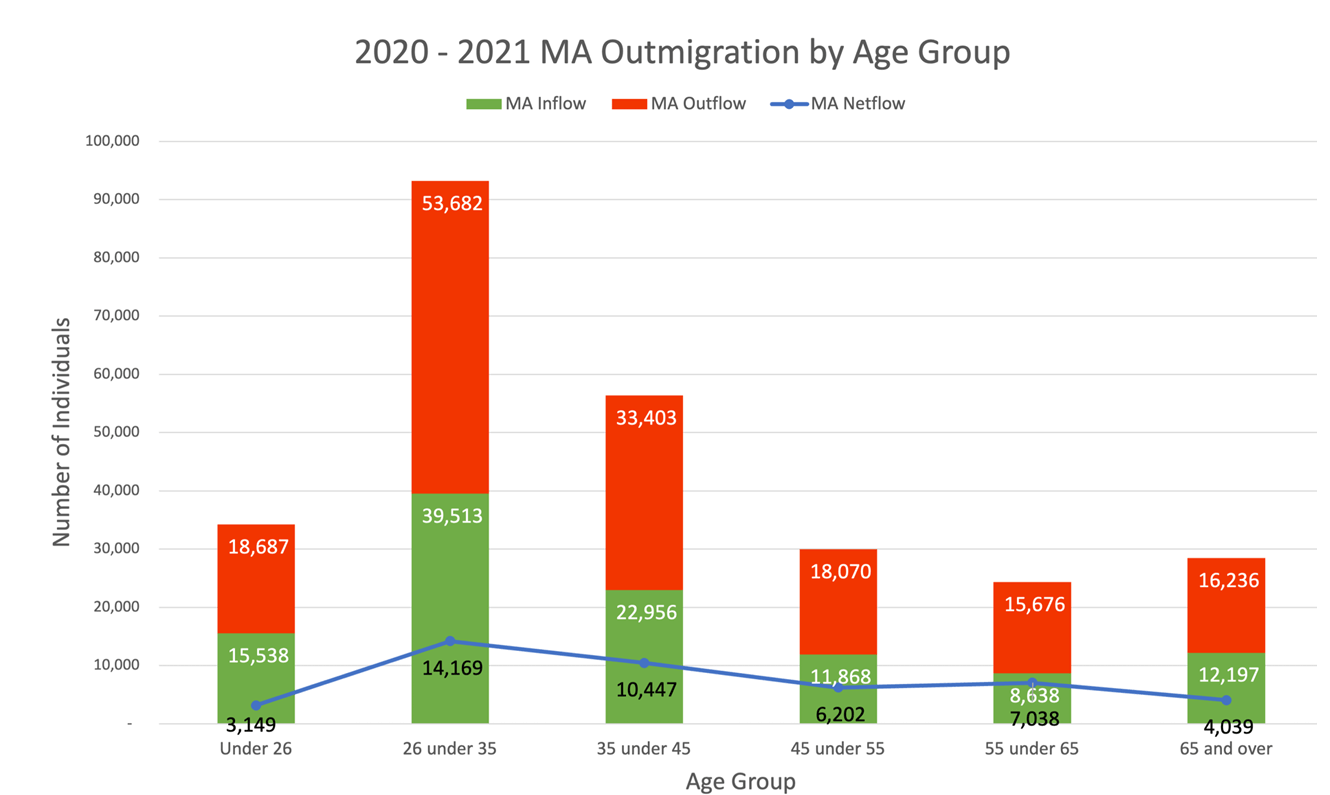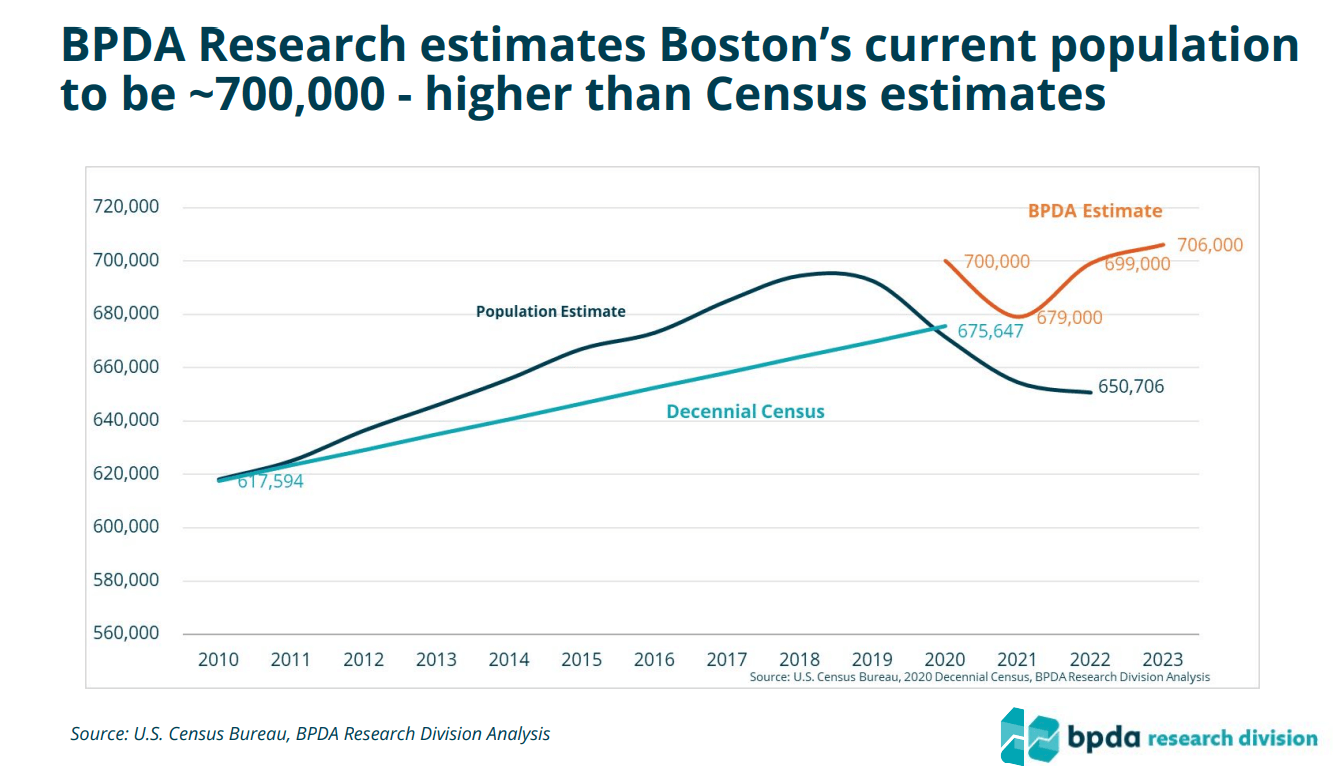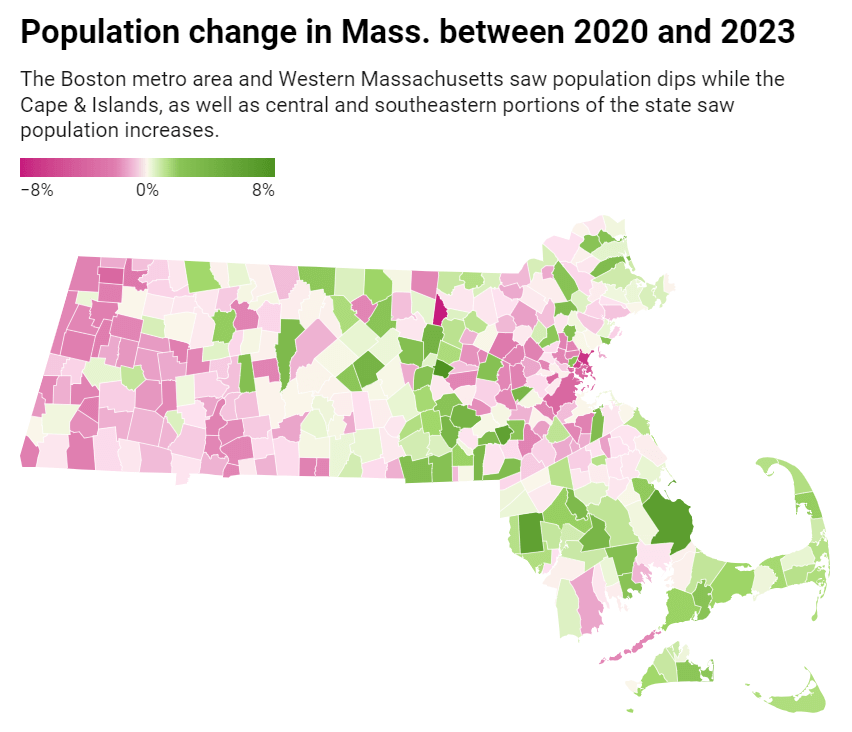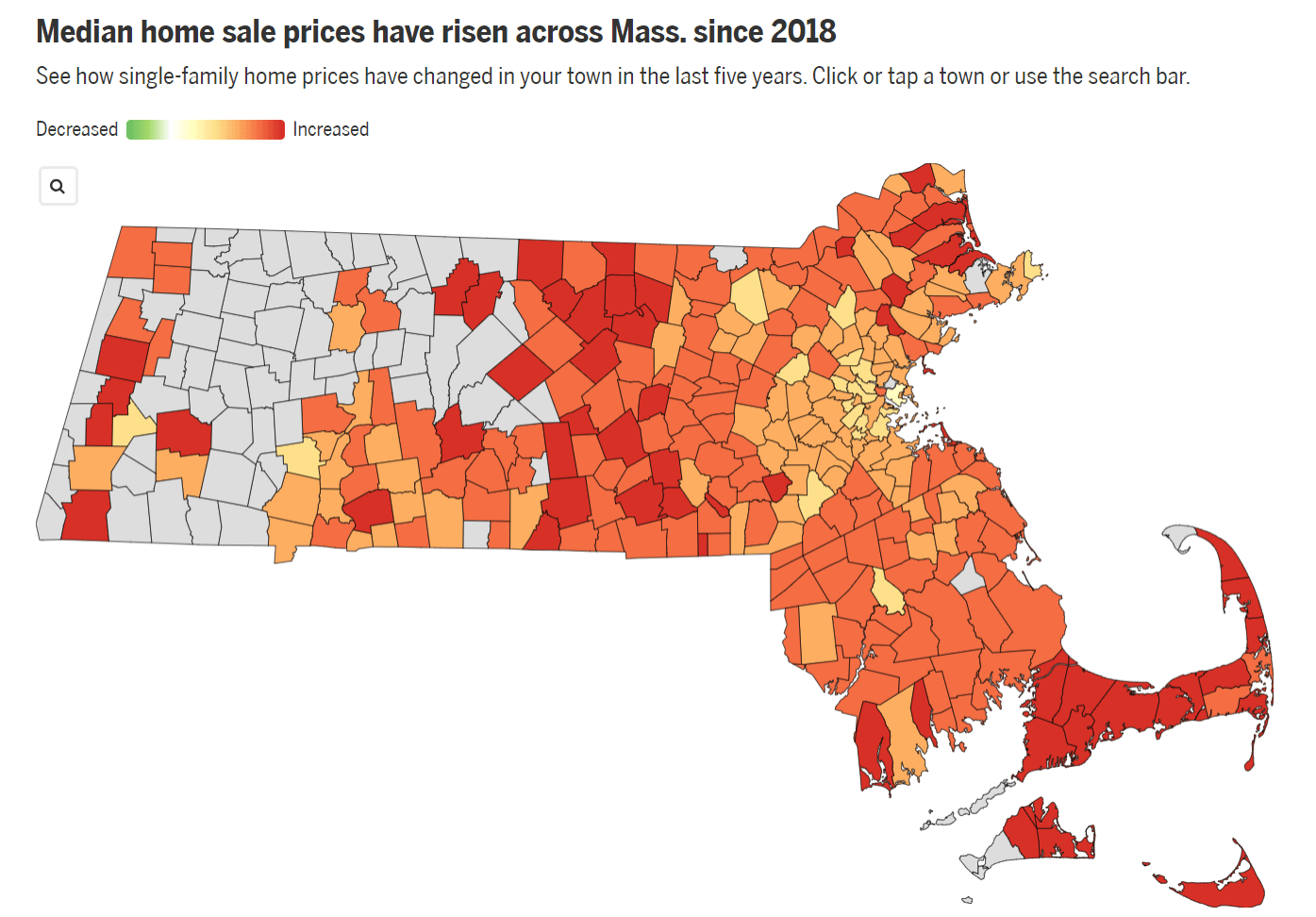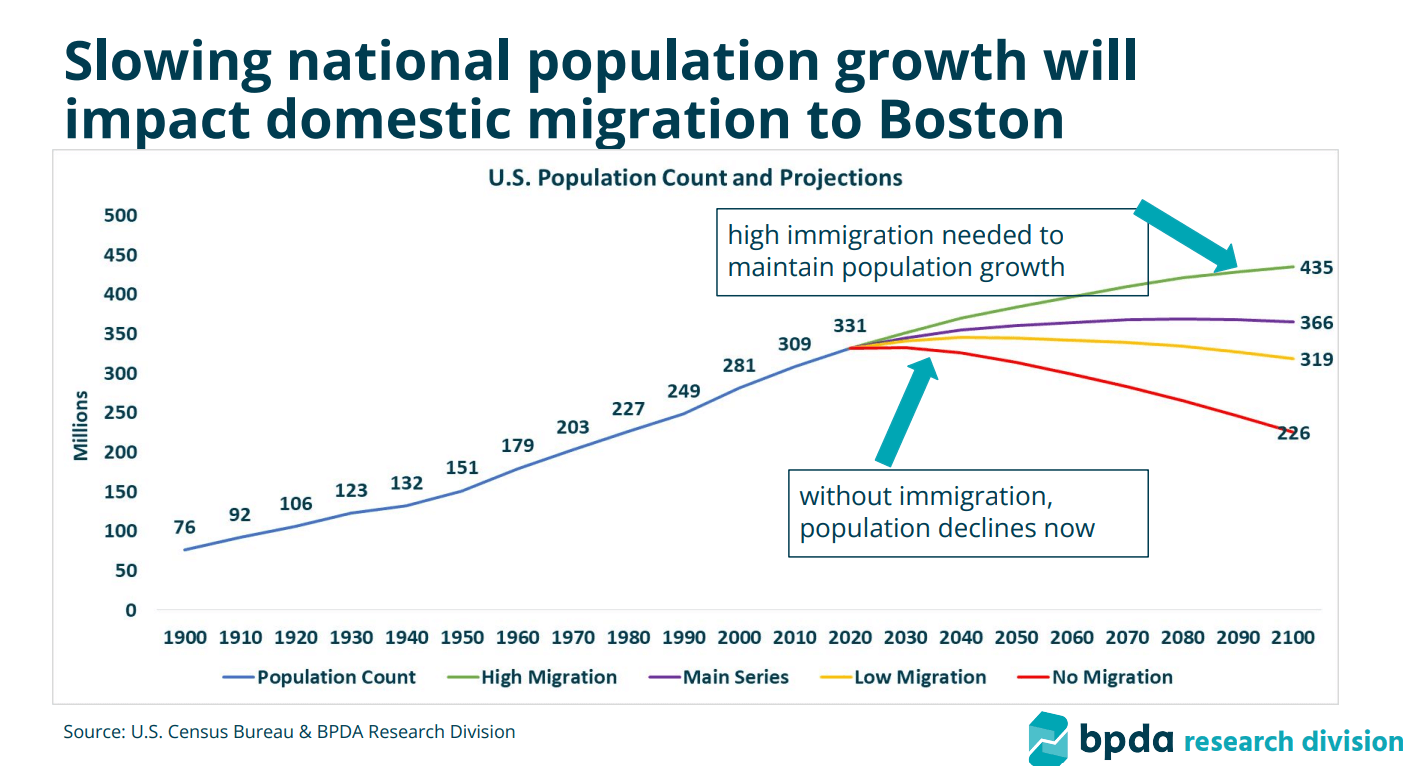Population Predictions for Boston and Massachusetts, 2020–2050
Boston, like its West End, is no stranger to marked population changes. Recent studies have predicted further transformations for Boston’s and Massachusetts’ populations that could have meaningful economic and political impacts. Such changes, current and future, are influenced by various interrelated factors: immigration patterns, cost of living, major disruptors, anchor institutions, and global population growth rate.
Population change is the story of America. The West End, Boston, the Commonwealth of Massachusetts, and the United States have all experienced dramatic changes in population for centuries. Cities and towns across the country have expanded and contracted through urbanization, migration, policies, and programs – including through Urban Renewal programs, in the West End’s case. Two studies released in April 2024 predict even more changes for Boston and Massachusetts that could have significant (and negative) economic and political impacts.
A study released in April 2024 by Boston University Questrom School of Business finance professor Mark Williams submits that “outmigration from the Commonwealth is accelerating at an alarming rate.” The author claims that people are leaving Massachusetts in increasing numbers due to high income taxes, high housing prices, and high healthcare costs. He also raises concerns that the largest segment leaving the state is 26-34 year olds, not the expected retiree segment. In the long term, Williams states, the Commonwealth could lose out on billions of dollars in income and taxes, significantly affecting the regional economy and potentially losing Congressional seats at the federal level. Recent news articles concur that the Commonwealth, and Greater Boston in particular, is becoming too expensive for many residents to stay.
Another April 2024 population report, published by the City of Boston’s Planning and Development Agency (BPDA), drills down to the city level and 25 years into the future. The BPDA paints a slightly better picture for the current and future population levels of Boston. The BPDA estimates that the most current (2023) population count for Boston is slightly above 700,000 residents, higher than the US Census estimates for the city. US Census numbers released in May 2024 show that Boston has lost about 25,000 residents since the decennial count in 2020 and is one of the highest losers in population in the state. The Boston report also predicts continued population growth for the next 20 years, albeit at a slower rate.
Although the two studies and the Census numbers are not necessarily directly comparable – one looks at current migration patterns, the other at future trends – they do bring up several variables that contribute to the number of people who call Boston home:
Immigration patterns at macro and micro levels: News of declining populations may be a surprise to some local leaders. Although the Williams study, BPDA, and US Census reports all analyze the same information, they view it through different lenses. Looking at a state-by-state basis as the Williams study does, Massachusetts is losing more residents than it is gaining. However, the US Census shows that population loss and gain vary greatly by municipality within Massachusetts. For example, many towns and cities in the western part of the state and Greater Boston lost population but numerous areas of Worcester and Plymouth Counties saw significant growth, sometimes reversing decades of loss. In-state migration often contradicts what is happening on a state or national level.
Cost of living: According to the Williams study, the high cost of housing, income taxes, and health care are driving residents out of Massachusetts. Although income taxes and health care costs are not necessarily different from one part of Massachusetts to another, the cost of housing is incredibly variable across the state. This likely explains why Worcester and Plymouth Counties, traditionally cheaper housing markets, have attracted residents from more expensive cities like Brookline and Braintree. Consequently, these same destinations have also seen a dramatic rise in housing costs over the past five years: maps of population increases and rising housing costs are strikingly similar. According to 2024 home price data, there are very few areas of the Commonwealth that are not affected by housing affordability.
Major disruptors: The COVID-19 pandemic indelibly changed the nature of work. More companies and organizations now allow employees to work from home either on a hybrid or full-time basis. These new arrangements have translated into a need for more space at home devoted to work. With commuting no longer a major factor, cheaper housing markets have become much more attractive.
Anchor institutions: Massachusetts and the Greater Boston area have the highest number of educational institutions anywhere in the country. These anchors have consistently drawn in new students every year, many of whom stay after graduation. In turn, companies source talent from these institutions and local residents are needed to run them. Colleges and universities generate enormous economic benefits to the state and are viewed by many as “recession proof.” The BPDA study hints at the importance of these institutions by showing that net migration to the city is positive only with young, college-age adults. But universities can be susceptible to declines, particularly if the domestic population continues to wither and immigration pipelines are slowed or shut off.
Global population decline and immigration: The population growth rate of the planet has been slowing down for the past twenty years. In a global economy largely based on growth, this decline is a problem. Shortages of people mean economic decline. The BPDA study states quite clearly that the population of the city of Boston for the future will be entirely dependent on international immigration. The United States has always been a destination for immigrants but slowing global population growth and changes in federal immigration policy could drastically, and quickly, impact the number of residents that call Boston home.
The alarms sounded by these two recent studies raise some interesting challenges for city and state officials. Retaining residents will undoubtedly require some efforts to reduce the costs of living, which, until recently, had been tolerated by workers attracted by local jobs. It remains to be seen, however, if these efforts can counter immigration patterns that do not look favorable to Massachusetts.
The West End Museum is dedicated to educating the public about issues of displacement, immigration, and urbanization, not only through looking at the neighborhood’s past, but also through thinking about its future.
Article by Daniel Spiess, edited by Grace Clipson.
Sources: Town-by-town map: See where median home prices have risen the most, The Boston Globe, June 3, 2024; BPDA Research Division, Boston’s Population: 2025-2050 and Implications, April 5, 2024; Map shows biggest population losers and winners in Mass. since 2020, MassLive.com, May 17, 2024; Massachusetts’ high housing costs are pushing out workers, WGBH, August 4, 2022; Mark Williams, et al, Massachusetts Outmigration Study, Boston University Questrom School of Business, April 24, 2024; How can we get growth back on track? World Economic Forum, January 18, 2024.


